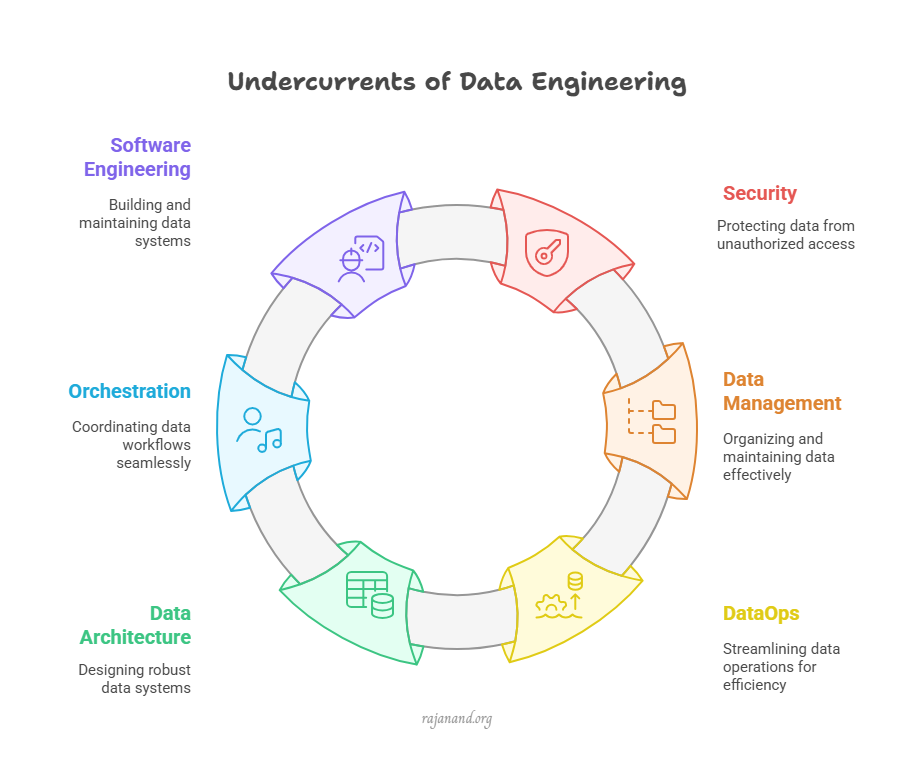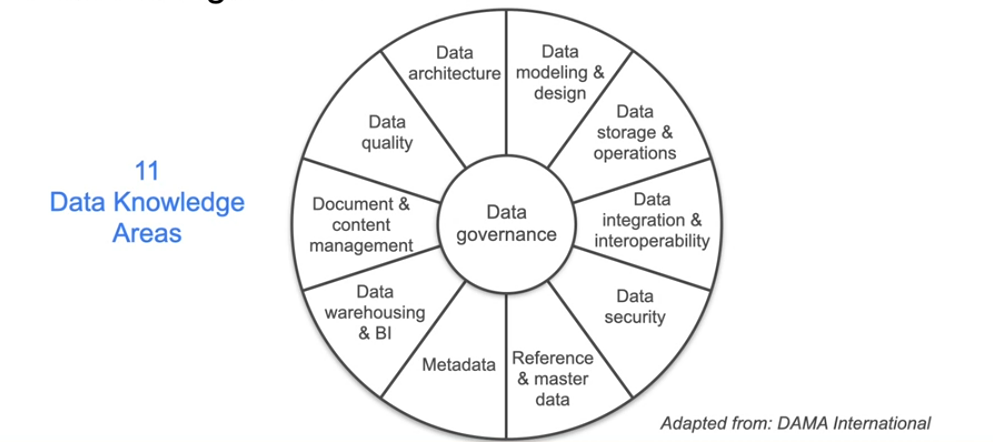Overview
- Undercurrents:
- Practices that apply across the entire data engineering lifecycle:
- Security
- Data Management
- Data Architecture
- DataOps
- Orchestration
- Software Engineering
- Practices that apply across the entire data engineering lifecycle:

Security
- Core Principle: Protect sensitive data (e.g., personal, proprietary).
- Key Practices:
- Principle of Least Privilege: Grant users/applications only the access they need.
- Data Sensitivity: Avoid ingesting sensitive data unless absolutely necessary.
- Cloud Security: Understand IAM (Identity and Access Management), encryption, and networking protocols.
- Cultural Aspect:
- Security is a shared responsibility across the organization.
- Avoid security theater (superficial compliance without a true security culture).
- Common Mistakes:
- Exposing S3 buckets or databases to the public internet.
- Ignoring basic precautions like secure password sharing.
- Key Takeaway: Security is about principles, protocols, and people.
Data Management
- Definition: The development, execution, and supervision of plans to deliver, control, protect, and enhance the value of data.
- DAMA (Data Management Association):
- Provides the Data Management Body of Knowledge (DMBOK).
- Covers 11 knowledge areas, including data governance, data modeling, and data integration.

- Data Governance:
- Ensures data quality, integrity, security, and usability.
- Central to all other data management areas.
- Data Quality:
- High-quality data is accurate, complete, discoverable, and timely.
- Poor data quality leads to wasted time, poor decisions, and loss of trust.
- Key Takeaway: Data management ensures data is a valuable business asset.
Data Architecture
- Definition: The design of systems to support the evolving data needs of an enterprise through flexible and reversible decisions.
- Key Principles:
- Choose Common Components Wisely: Use components that facilitate collaboration.
- Plan for Failure: Design for both success and failure scenarios.
- Architect for Scalability: Build systems that scale up and down with demand.
- Architecture is Leadership: Think like an architect to lead and mentor others.
- Always Be Architecting: Continuously evolve systems to meet changing needs.
- Build Loosely Coupled Systems: Use interchangeable components for flexibility.
- Make Reversible Decisions: Ensure design choices can be easily changed.
- Prioritize Security: Apply security principles like least privilege and zero trust.
- Embrace FinOps: Optimize costs while maximizing revenue potential.
- Key Takeaway: Good data architecture is flexible, scalable, and secure.
DataOps
- Definition: A set of cultural habits and practices borrowed from DevOps to improve the development and quality of data products.
- Key Pillars:
- Automation:
- Use CI/CD (Continuous Integration/Continuous Delivery) for data pipelines.
- Automate tasks like ingestion, transformation, and serving.
- Observability and Monitoring:
- Monitor pipelines to detect failures early.
- Avoid bad data lingering in reports or dashboards.
- Incident Response:
- Rapidly identify and resolve issues.
- Foster open and blameless communication.
- Automation:
- Key Takeaway: DataOps improves efficiency, quality, and reliability of data systems.
Orchestration
- Definition: Coordinating and managing tasks in data pipelines.
- Approaches:
- Manual Execution: Useful for prototyping but not sustainable.
- Pure Scheduling: Automate tasks at specific times but lacks dependency management.
- Orchestration Frameworks:
- Tools like Apache Airflow, Dagster, Prefect, and Mage.
- Automate tasks with dependencies and monitoring.
- Directed Acyclic Graphs (DAGs):
- Represent data pipelines as flowcharts with nodes (tasks) and edges (dependencies).
- Ensure data flows in one direction without loops.
- Key Takeaway: Orchestration frameworks automate and optimize data pipelines.
Software Engineering
- Core Skill: Write clean, readable, testable, and deployable code.
- Languages and Frameworks:
- SQL, Python, Bash, Spark, Kafka, Java, Scala, Rust, Go.
- Key Areas:
- Data Processing: Write code for ingestion, transformation, and serving.
- Open Source Contributions: Contribute to frameworks like Apache Airflow.
- Infrastructure as Code: Automate infrastructure setup using code.
- Key Takeaway: Strong software engineering skills are essential for adding value as a data engineer.
Key Takeaways
- Undercurrents:
- Security, Data Management, DataOps, Data Architecture, Orchestration, and Software Engineering are foundational to data engineering.
- Security:
- Protect data through least privilege, encryption, and a security-first culture.
- Data Management:
- Ensure data is high-quality, secure, and usable through governance and best practices.
- Data Architecture:
- Design flexible, scalable, and secure systems that evolve with business needs.
- DataOps:
- Automate, monitor, and respond to incidents to improve efficiency and reliability.
- Orchestration:
- Use frameworks like Apache Airflow to automate and manage complex data pipelines.
- Software Engineering:
- Write production-grade code to build and maintain robust data systems.
Source: DeepLearning.ai data engineering course.
